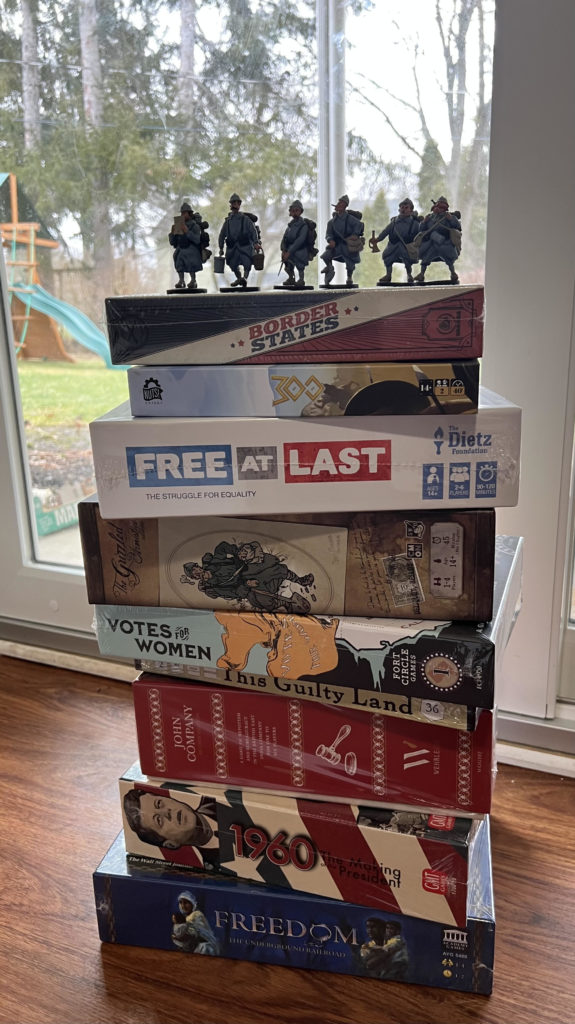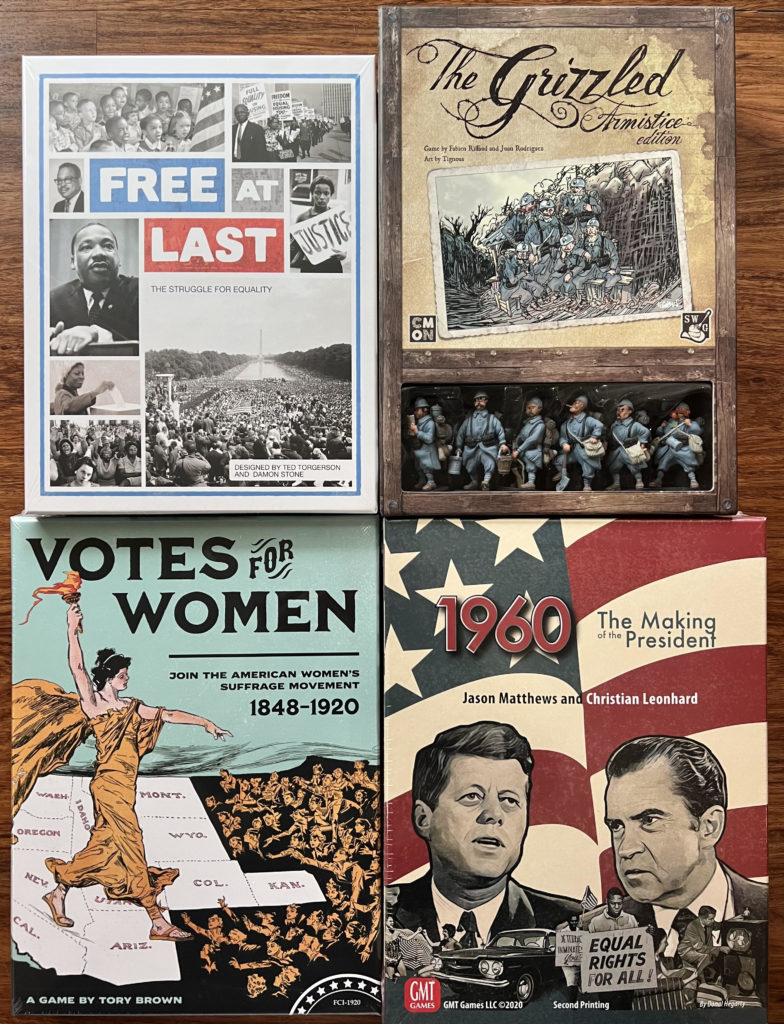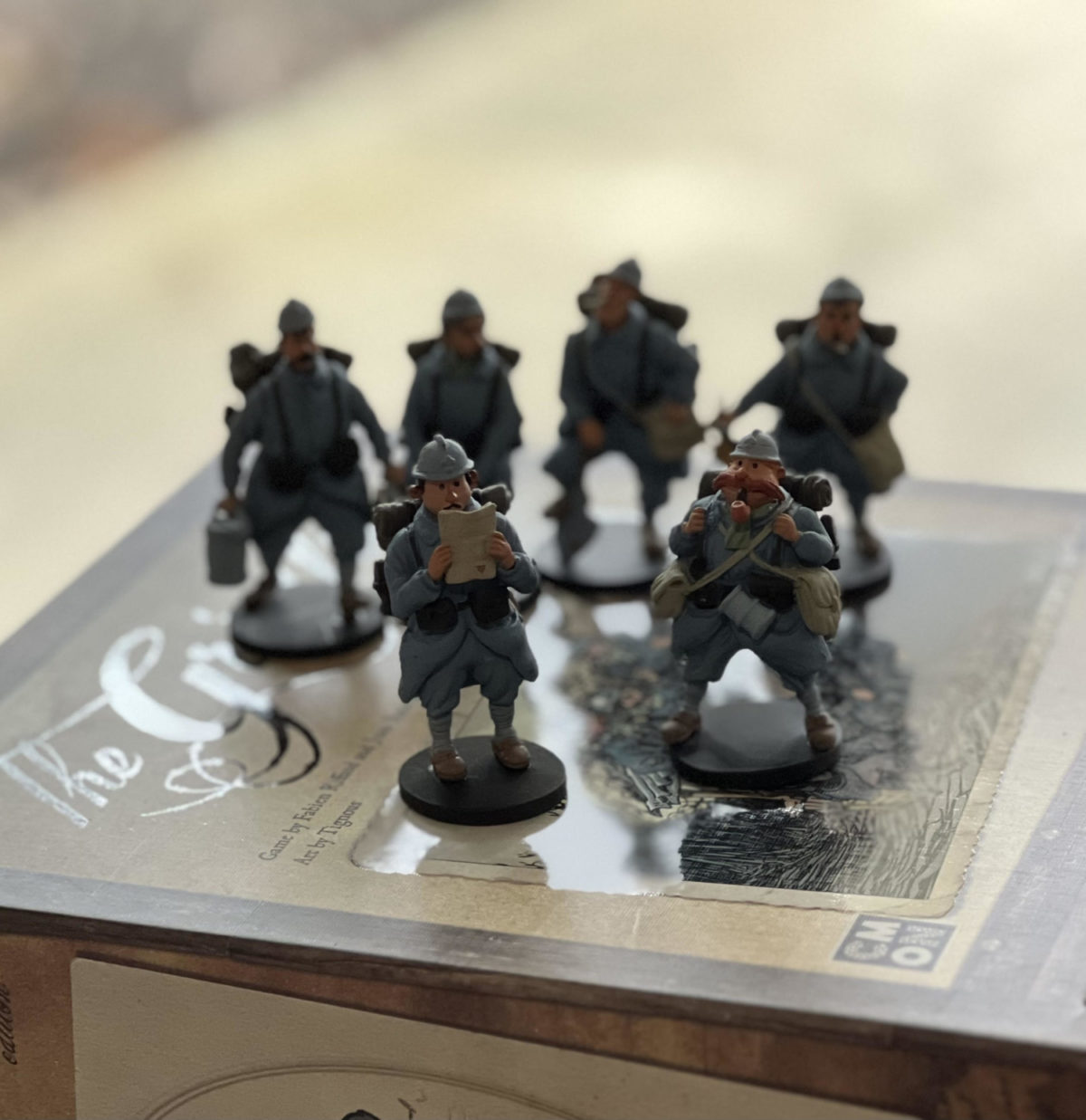There are broadly three main ways in which commercial board games intersect with history:
- there are what we might call games as history quizzes,
- history as backdrop to games which really aren’t about history at all,
- and games that do attempt some kind of representation of history.
Games as history quizzes test a player’s knowledge of history, for the purposes of education and/or entertainment. Commercial examples of this kind of game are Chronology (1996) and Timeline (2012). In both instances players place cards in the correct sequence in a chronology formed by a tableau; if they’re right, they get to discard and get closer to winning the game. If players are wrong, they pick up another card and so are further from winning the game.
There are games that use history as a backdrop and make no serious attempt to engage with the subject matter, which they really leverage for design and marketing purposes. Commercial examples of this kind of game are Battle Line (2002), Puerto Rico (2002), and London (2010). These games make no serious attempt to represent the historical record connected to the battles of Alexander the Great, the colonization of the island of Borinquén, or the development of the city of London. Such games exploit the potential of a given historical setting to engage the imagination of an audience and to help communicate the mechanics within the game design. We might, in very broad terms, call games shaped predominantly by their mechanics ‘eurogames’, although there are considerable problems with such a breadth of definition as we shall return to later in this blog post.
In games where some attempt at representational history is made there is at least some endeavour to engage with the history beyond the concerns of marketing and to help explain the game mechanics. In such games there is an intentional engagement with the subject matter to the extent that some kind of thesis on the subject matter is usually being consciously projected through the nature of the design. Such a thesis is usually defensible through arguments connected to historical research. Commercial examples of such games are common within the wargames sector of the board gaming world – Twilight Struggle (2005), Washington’s War (2010), and Quartermaster General (2014) being just some amongst many.
In these kinds of games, we may even claim some kind of model representing one or more aspects of history is being projected. To this extent we may say that the game design is, in some sense, serving history, serving the pursuits of engaging with history, rather than history merely serving the game design. Within this broad category there is a broad spectrum. Some games attempt to represent more complex aspects of history and these attempts may be more or less abstract and be more or less coherent or defensible.

All of these design approaches to the intersection of history and games can encode simplistic or problematic perspectives, consciously or otherwise suppressing, distorting, obliterating, or amplifying certain aspects of the historical record. Eurogames, such as Puerto Rico, may so exploit history that they distort it beyond recognition, and then, wittingly or not, promote this distortion to audiences far and wide. But a game that consciously attempts to represent history may do it poorly, and a game that makes no conscious attempt to represent history may still hit on something of representational value.
Development Process in Wargames
As stated above, wargames are a sub-sector of board games where usually some serious engagement with history is being attempted. Within this sector ‘development’ is a term with a meaning often distinct from ‘design’. Where ‘design’ is considered the initial conception of a game up to a playable prototype, with or without written (or comprehensible) rules, ‘development’ is the refining of the game, testing, and revising it through to publication.
Wargames are often termed ‘conflict simulation games.’ This helps to foreground their concern not with war-mongery, but with conceiving history in the context of interlinking systems engendering narrative variability. Wargames present history as a form of model, allowing us to imitate history, and thereby to better understand it and the motives and options of participants within it. Necessarily, these models are tightly circumscribed, attempting a narrow focus on specific constrained aspects.
It’s commonplace for wargames – or conflict simulation games – to begin as a thesis – a set of related concepts that facilitate non-deterministic outcomes. As these concepts formulate the mechanics that best articulate the thesis come into view – and sometimes there is some push-and-pull between the thesis and the mechanics. But, ultimately, something sufficiently stable to be termed a ‘design’ is derived, and a prototype is built (often now in a digital format to help communication with playtesters and publishers) and makes its way to a development team.
In edition Nr.35 (2022) of long-running wargames magazine C3i, Jason Carr, Director of Game Development at GMT Games, wrote an article about the development process in board wargames. He discerned five key phases that tend to run chronologically and are neatly representative of the development process:
- Modeling – this is where the thesis is refined and clarified; the game systems may be reorganized so there is clear priority to assist in the articulation of the key narrative, or narratives embedded in the design.
- Mechanics – a similar process often simultaneous with development of the model, where mathematical expressions of the thesis are clarified, and reorganized.
- Usability – with modeling and mechanics refined, a prototype gets built, and usability is about checking, through the play of physical (and digital) prototypes, that the physical components are fit for purpose – are the tracks on the board in the right place? Are they even functional as intended, are the pieces the right size and colours? Is the layout of card decks pretty but non-functional, are people getting bored of all the dice rolls? Are there rules which seemed clear in design but players are routinely confusing players? (Digital prototypes of board games do have their uses, but are certainly no substitute for actual physical prototypes.)
- Balance – with a number of wargames concerned with asymmetric qualities (like irregular and insurgent warfare) and with the concern to generate a meaningful model, balance doesn’t mean everyone always necessarily has the same chance of winning. Indeed it might mean reducing chances to win for a certain player at a certain time, or restricting the means of victory in order to preserve the model. This might mean adjustments to the mathematics baked into the game – in which case, we would consider that re-balancing. Or perhaps the model needs reworking because it’s too deterministic, and doesn’t allow for sufficiently interesting choices for one player, or in a specific set of circumstances, ‘breaking’ the game. In this case, this is more likely to be considered re-design.
- Completeness – with a functioning model, with the right mechanics to support it, with the right components working in the right ways, and with a balance that seems to satisfy both the intentions of the model and experience of players, completeness is the phase where rulebooks are revised, final components are printed and sourced such that a publisher is able to ship the game.
Trends in Historical Representation Games
Since the turn of the late 1990s we have seen more games embrace history without focusing directly, or even indirectly, on war. We now have games such as Liberté (1998), about the political competition in the French Revolution. 1960: The Making of The President (2007) is about the Nixon versus Kennedy election campaign. Freedom: The Underground Railroad (2012) is about freeing slaves in the ante-bellum US. An Infamous Traffic (2016), and This Guilty Land (2018), focus on the opium trade and slavery. The Grizzled (2015) may have its locus in the trenches of World War I, but it’s a cooperative game about friendship and survival, in the face of the brutal extremities of war, and might not be best described as a wargame at all.

We have games like Churchill (2015) – a semi-co-op game where players are either the British, the US, or the USSR, and all competing with each other at conferences as they all also work together to defeat the Axis powers. Versailles: 1919 (2020), Congress of Vienna: 1815 (forthcoming), and Prime Minister (forthcoming) give us political history without the focus on the conduct of war. Indeed, games like Peace: 1905 (forthcoming) are concerned with negotiating a treaty to secure peace that ends a war. We also have Votes for Women (2022) about women’s suffrage in the US, and Free At Last (2022) about the civil rights movement, and Molly House (forthcoming) about surviving in 1720s London as gender defying-queers, giving us social and gender-conscious history.
We even have Wiñay Kawsay (forthcoming) a game about being an historian arguing for a particular interpretation of the site of Machu Picchu – it’s not so much a history game as an historian game. (‘Wiñay Kawsay’ means “history” in Kichwa, the language family of the Inca.)
This expansion into other historical topics is not coincidental to the rise in eurogames. It is, in some significant measure, a direct result of it. The game mechanics, the functionality of game boards, and whole strands of grammar of wargames, with resource management, and player ‘actions’, and multifunctional cards now being familiar concepts within board wargames. There is some irony here to unpack. Wargames derive from military and colonialist traditions. Eurogames emerged as a movement away from and a counter to the direct conflict-driven focus of wargames. Eurogames sit within a commercial space associated with broad accessibility, with families, and tend to focus on interpersonal interaction (Woods 2012, 155), and Eurogames are now at the heart of what we might describe as mainstream board gaming (Woods 2012, 6, 83).
Yet mainstream board gaming is sorely afflicted with critiques of colonialism (Faiduti 2017, No Pun Included 2021, Shelf Stories 2021), and I suggest this niche space of historical board wargaming, despite the irony of its military and colonialist provenance, is reaching its postcolonial moment well-ahead of mainstream board games. Indeed Patrick Rael, Professor at Bowdoin, has made the same observation (Shelf Stories 2022). Wargames, with their focus on a coherent thesis, their concern with historical detail, their aspiration to model history, are in a sense teaching eurogames how to engage with history seriously. Meanwhile, eurogames help facilitate the dissemination of history into broader concepts, demographics, and play styles.
Indeed, we now have games that are sometimes called Waros or Weuros (BGG 2006). Games like Condottiere (1995), Martin Wallace’s Waterloo (2009), A Few Acres of Snow (2011), Scythe (2016), Undaunted: Normandy (2019), and Freeman’s Farm: 1777 (2019) might fit within this description, although there seems little consensus. It’s perhaps becoming meaningless to speak of a clear delineation between euro and wargame.
We now have different themes, with different associated mechanics, from different perspectives. We have solo games, games that must be played by certain numbers of players, co-op games, semi-co-op games, story-driven games, and hybrid (digital-analog fused) games. These all permit us more expansive ways of engaging with history from multiple perspectives in a greater range of formats maximizing our potential to reach people and infuse and foster a meaningful relationship with history.
There is every reason to expect this trend to continue.
References
BGG. November 5, 2006. “Waros or Weuros: Which is the right word for euro-wargames?” BoardGameGeek.com. Accessed January 13, 2023. https://boardgamegeek.com/thread/133826/waros-or-weuros-which-right-word-euro-wargames
Carr, Jason. “What is Game Development?” C3i, Nr. 35. 2021, 40-41.
Faidutti, Bruno 2017. Accessed January 13, 2023. https://faidutti.com/blog/blog/2017/06/02/postcolonial-catan/
No Pun Included. “Colonialism – The Board Game Struggle.” February 19, 2021. Accessed January 13, 2023. https://youtu.be/VQuFSxs9VXA
Shelf Stories. Checking Slavery and Colonialism in Board Games. January 4, 2021. Accessed January 13, 2023. https://www.youtube.com/watch?v=ytCmiFwr8GQ&t=1s
Shelf Stories. War Games Are Better at History Than Euro Games? with Dr. Patrick Rael. August 10, 2022. Accessed January 13, 2023. https://www.youtube.com/watch?v=8GmOZdC5fEI
Woods, Stewart. 2012. Eurogames: The Design, Culture and Play of Modern European Board Games. Jefferson, NC. McFarland & Company.
Maurice Suckling is currently an Assistant Professor at RPI in Upstate NY, where his research interests are storytelling in games, board and card games as storytelling systems, and history in board games. Maurice’s first game was Driver, in 1999. He has worked on over 50 published video games, mostly as a writer, including Fortnite, Killing Floor 2, Borderlands: The Pre-Sequel, and Civilization VI. He also designs historical board games and is a Charles S. Roberts Award winner for his Chancellorsville: 1863 (2020). He holds a PhD in Creative Writing from Newcastle University, and a Masters in Global History from Birmingham University.
